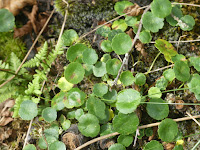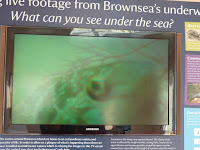I'm lucky enough to be able to apply to stay at the castle (prounced ca-sull, not carr-sull) on Brownsea Island and I recently just spent a week there with my family. I have stayed previously but the first time was with a toddler, and the second time was to celebrate Scouting's centenary on the island of it's birth so this time I hoped to see a little more nature with the boys being teenagers now.
I had searched for any detailed information on the flora and fauna on the island and only really found fairly standard Avocet/ Red Squirrel/ Alder/ Sika-esque lists. I have added all that I saw during my August stay at the end of this in case it is of any future use. I've done my best to correctly identify species but any corrections would be welcomed.
I had searched for any detailed information on the flora and fauna on the island and only really found fairly standard Avocet/ Red Squirrel/ Alder/ Sika-esque lists. I have added all that I saw during my August stay at the end of this in case it is of any future use. I've done my best to correctly identify species but any corrections would be welcomed.
We caught the castle's ferry from the quay in Poole Harbour with the sky full of several different types of cloud and the weather was set fair for the week.
To be able to stay on the island is an absolute privilege and this wasn't lost on me. This gives you the ability to explore at any time during the day, but crucially outside of the 10am-5pm period that the tourist ferries run to, the only exception being the temporary theatre on the occasional evening but even then it was a static audience. The sea during during my stay always started off like a mill pond first off. This is taken just past two old WW2 gun platforms facing Old Harry Rocks.
I had said to Pablo on my tracking 1-2-1 that I would try and get him some Sika Deer fewmets, as well as some stripped Scots Pine cones courtesy of the Red Squirrels and both were easily found in fact, the fewmets were so fresh that they initially formed condensation in the plastic bag!
There is a tale that the last reclusive owner of the castle had let the island get so covered in Rhododendrons that access was difficult. They are still here and being pro-actively managed.
Seeing the squirrels is a little bit of pot luck but early morning was the best time before the boats arrive and you can often hear that they are close due to a regular stream of debris dropping from the Scots Pine, Oak and Beech trees from which they were getting sustenance. There is a specific pine copse which is accessed via gates to not only consolidate the main squirrel food source but to keep the ravenous deer from eating the saplings.
Talking of the deer I wasn't so sure where to look, the open greens were an obvious area to (it's where I collected the afore mentioned fewmets from) but it was where they went during the day that I was interested in where they could hide away during the day on a popular accessible island a mile-and-a-half long so that I could get my trail cam in position.
The soil is fairly sandy going onto almost loam like in some areas so sign doesn't stand out massively, for a photo at least, but the occasional mud trap yielded superior shots.
Near the public hide which is accessed not far from the NT jetty there is a marshy area with lots of Alder, Rush and Fleabane growing in it and there's a raised walkway across it that takes you to the reserve itself. It soon became obvious from the greenery that it had been walked through, coupled with an area which had what looked like tracks through it, and this one had the sludge follow through as a deer raised it's leg. and it soon became clear that the reeds were massively disturbed too so I reckon I had my answer.
Further investigation of the area in and around the reeds confirmed that this would be a good camera trap spot. It also turned out to be a site where the occasional Nightjar could be spotted; the bird that looks like a raptor and flies like a bat.
It would be easy to focus in on the island's marquee species but Brownsea Island reminds me a little of the RSPB site at Minsmere in that it has several different habitats: Sea, coast, heathland, broad leaved coniferous and mixed woodland, freshwater lakes, greens and a lagoon-Not to mention a castle, the National Trust building, Chinook helicopters, day visitors and the previously mentioned temporary open air Shakespearean theatre adding to the mix! All of this, plus the island's location, made for a quite eclectic experience as for instance you could be looking at Squirrels in a Scots Pine with the noise of the sea crashing in your ears. This is a shot of the heathland which was the superor area to get some fantastic Nightjar and Dartford Warbler sightings in whilst there, with the noisy Scout campsite over my right shoulder.
It wasn't all nature walks around the island, I decided that there would be some hammock time built in and this was on the top of a hill overlooking the sea on a hot day with a cool breeze to make it a fine downtime moment.
The beach was an excellent source of sign and and again the privilege of being able to go out in the early morning was not lost. The two best prints that I saw were this deer track and what I believe to be a Heron due to the size, the fact that it is slightly asymmetrical and the fact that I'd seen them on the coastline. All often seen with the accompaniment of Gulls, Terns, Oystercatchers, the sea, rustling tree leaves, boats and often Peacocks.
I found these tracks by the second lagoon hide in the reserve. It is accessed by a walkway and therefore these tracks were some way from squirrel territory so I'm making the call that it's rat sign. I've seen it suggested online that there are no rats on the island but there are as I captured some on my trail cam as you'll see below.
And one final reference to the eclectic nature of the island; this shot is taken from the reserve walkway looking over the 'camera trap' reedbed, there is a theatre interval playing what we referred to as 'Hey nonny nonny music' behind me, Poplar tree leaves rattling above me, the reeds in front of me blowing in the wind and rustling due to deer activity (as well as their occasional barks), Terns making a racket on the lagoon and a ferry pulling into Poole just over the lagoon wall, all this to set up my trail cam and catch a glimpse of Nightjars!
I could go on all day...I personally rank the island right up there with somewhere like Skomer in Wales, do visit if you can. Now the nature sightings list below is still work in progress and any information would be warmly received, and if you are visiting I'd also suggest checking the Dorset Wildlife Trust Brownsea and the NT Brownsea Twitter pages too. The sequence below is title, opening sentence, pictures and listings in each section.
Animals.
I have so many decent deer and squirrel shots that I have made two separate pages. Click here for the squirrel page and here for the deer page.
Sika Deer, Red Squirrels, Rats, Rabbits
Birds.
A fair few types were seen and I also saw reports of a Firecrest near the public lagoon hide but didn't see it myself.
Chaffinch, Peregrine Falcon, Herring Gull, Black Headed Gull, Lesser Black Backed Gull, Sandwich Tern, Common Tern, Spoonbill, Little Egret, Robin, Wren, Cormorant, Goldfinch, Oystercatcher, Black-Tailed Godwit, Avocet, Grey Heron, Nightjar, Moorhen, Shelduck, Woodpigeon, Blackbird, Crow, Magpie, Jackdaw, Mallard, Pied wagtail, Mistle Thrush, Goldcrest, Darford Warbler, Blue Tit, Great Tit, Long-Tailed Tit, Goldcrest, Mute Swan, Spotted Redshank, Turnstone
Butterflies, Moths and Insects.
The animals, birds, trees and flowers were easy to record but with it being a family holiday I couldn't focus on the six legged inhabitants quite as much. I've included Cinnabar Moths on the basis that I saw their caterpillars on some Common Ragwort.
Comma, Painted Lady, Red Admiral, Brimstone, Small Copper, Common Darter, Keeled Skimmer, Brown Hawker, Holly Blue, Midge, Labyrinth Spider (web I think), Pebble Hooktip, Crane Fly, Black-veined White, Cinnabar Moth, Earwig, Field Grasshopper, Digger Wasp, Honey Bee, Black-veined White, Large White, Mosquito.
Trees and Shrubs.
The island has a fair few varieties and whilst I can identify Sallow I'm not so hot at other Willow id but that said, it's made harder anyway due to hybridisation.
Sallow, Poplar, Pendunculate Oak, Hornbeam, Yew, Hawthorn, Hazel, Gorse, Scot's Pine, Holly, Buddleia, Sycamore, Beech, Ash, Osier, Cherry, Monterey Pine. White Willow,
Flowers and Plants.
There's a good amount of flowers and plants to be seen but some, like the Centuary, I only saw in one small patch of a green (and curiously one flower has four petals in the picture), and I only saw some things like Scarlet Pimpernel within the castle grounds. Note the earthenware around the Thorn-apple, this was found over on the South East side where an ultimately unsuccessful pottery business was started in the 1800s. The beach on that side is literally covered in broken pieces.
Ivy, Ling, Marsh Samphire, Glasswort, Kidney Vetch, Hops, Ground Ivy, Orache, Dock, Ivy-Leaved Toadflax, Sea Beet, Common Polypody, Wood Sage, Broadbell Heather, Scarlet Pimpernel, Bracken, Marsh Thistle, Centuary, Marsh Pennywort, Sea Buckthorn, Woody Nightshade, Tufted Vetch, Common Ragwort, Spear Thistle, Sea Mayweed, Black Woodshade, Goosefoot Trefoil, Common Thistle, Fleabane, Silverweed, Nettle, Common Reed, Aaron's Rod, Hemp Agrimony, Thorn-apple, Gypsywort, Hart's Tongue Fern, Viper's Bugloss, Hoary Willowherb, Pendulous Sedge, Soft Rush, St. John's Wort, Bramble, Creeping Buttercup.
Sealife and Plants.
Not totally sure on my id but I'll put it out there anyway. The Shore Crab is one we caught off the castle jetty and the TV is also on the jetty, linked to an underwater camera and the fish posing is a Wrasse. On a previous trip to the castle I've also seen Sea Bass caught from the same location. I also found a Spider Crab shell on the beach, along with Cockle and other similar shells.
Rock Samphire, Marsh Samphire, Sea Lettuce, Wrasse, Shore Crab, Blenny, Bootlace Weed, Bladderwrack, Limpet.
Micellaneous.
This is the section were I've seen stuff doesn't either doesn't really fit in or I simply can't identify.


































































































No comments:
Post a Comment